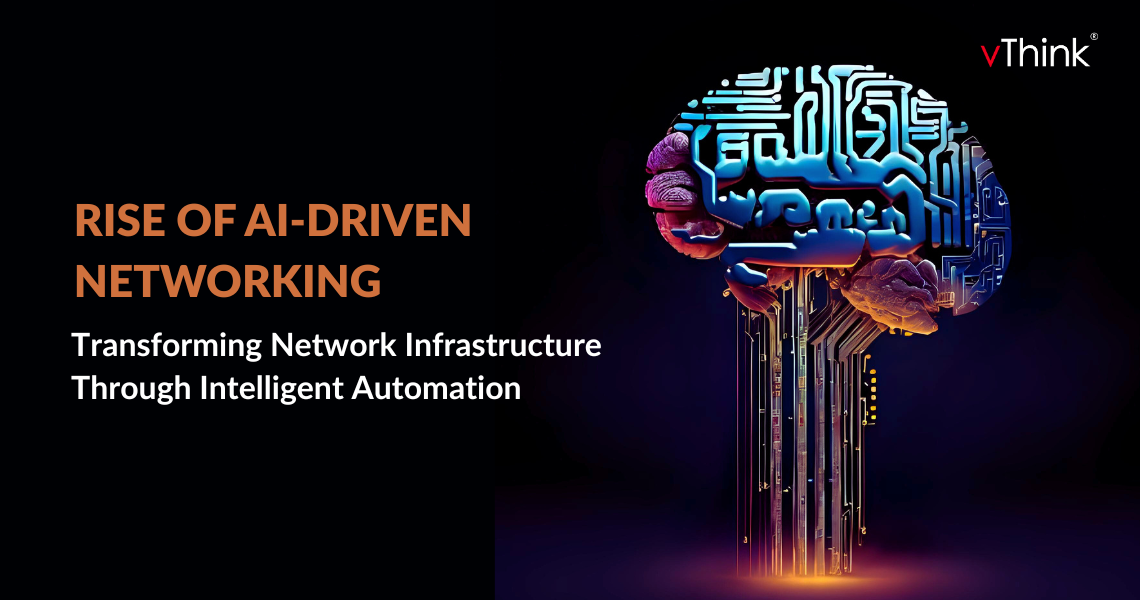
Rise of AI-Driven Networking: Transforming Network Infrastructure Through Intelligent Automation
The networking landscape is undergoing a revolutionary transformation as artificial intelligence (AI) becomes deeply integrated into network infrastructure, management, and operations.

Introduction
The networking landscape is undergoing a revolutionary transformation as artificial intelligence (AI) becomes deeply integrated into network infrastructure, management, and operations. AI-driven networking represents a paradigm shift from traditional reactive network management to proactive, intelligent systems that can predict, adapt, and optimize network performance in real-time. This technological evolution is reshaping how organizations design, deploy, and maintain their network infrastructure.

What is AI-Driven Networking?
AI-driven networking refers to the integration of artificial intelligence and machine learning technologies into network infrastructure to automate, optimize, and enhance network operations. This approach leverages advanced algorithms, data analytics, and intelligent automation to manage network resources, predict failures, optimize traffic flow, and provide enhanced security measures.
Core Components of AI-Driven Networking
- Machine Learning Algorithms: Learn from network data patterns to make intelligent decisions.
- Predictive Analytics: Forecast network issues and performance bottlenecks.
- Automated Network Management: Configure, monitor, and troubleshoot automatically.
- Self-Healing Networks: Detect and resolve problems automatically.
- Intent-Based Networking (IBN): Understand business intentions and translate them into policies.
Machine Learning Algorithms: These systems learn from network data patterns to make intelligent decisions about traffic routing, resource allocation, and threat detection.
Predictive Analytics: AI systems analyze historical and real-time data to forecast network issues, capacity requirements, and performance bottlenecks before they impact users.
Automated Network Management: Intelligent systems can automatically configure, monitor, and troubleshoot network components without human intervention.
Self-Healing Networks: AI-enabled networks can detect problems and automatically implement solutions, reducing downtime and improving reliability.
Intent-Based Networking (IBN): Networks that can understand high-level business intentions and automatically translate them into network policies and configurations.
Where AI-Driven Networking is Being Implemented
From enterprise networks to data centers, telecommunications, campus environments, industrial IoT, service providers, and edge computing, AI is revolutionizing how networks are managed and scaled.
Enterprise Networks
Large corporations are implementing AI-driven networking to manage their complex, distributed network infrastructure across multiple locations, cloud platforms, and remote work environments.
Data Centers
Cloud service providers and enterprises use AI to optimize data center networking, improving efficiency in server-to-server communications and resource allocation.
Telecommunications
Telecom operators leverage AI for network optimization, predictive maintenance, and service quality management across their vast infrastructure.
Campus Networks
Universities and large organizations implement AI-driven networking to manage wireless access, optimize bandwidth allocation, and enhance security across campus environments.
Industrial IoT Networks
Manufacturing and industrial facilities use AI networking to manage thousands of connected devices, sensors, and automated systems.
Service Provider Networks
Internet service providers and cloud providers use AI to optimize traffic routing, manage network congestion, and improve service delivery.
Edge Computing Networks
AI-driven networking is crucial for managing distributed edge computing infrastructure and optimizing data processing at network edges.
When AI-Driven Networking Emerged and Current Timeline
Historical Development
Early 2000s: Initial research into applying AI concepts to networking began with basic automated network management tools.
2010-2015: Software-Defined Networking (SDN) emerged, laying the groundwork for programmable networks that could be controlled by intelligent systems.
2015-2018: Major networking vendors began developing AI-powered network management platforms and introducing machine learning capabilities.
2018-2020: Intent-Based Networking (IBN) solutions became commercially available, marking the beginning of mainstream AI adoption in networking.
2020-2022: The COVID-19 pandemic accelerated adoption as organizations needed intelligent solutions to manage remote work and hybrid infrastructures.
2023-2025: AI-driven networking becomes mature with widespread enterprise adoption and advanced capabilities like autonomous networks.
Current State (2024-2025)
Today, AI-driven networking is in its growth phase with major technology vendors offering comprehensive AI-powered networking solutions. Organizations across various industries are actively implementing these technologies to address modern networking challenges.
How AI-Driven Networking Works
Data Collection and Processing
AI-driven networks continuously collect data from various sources including network devices, applications, user behavior, and external threat intelligence. This data is processed using advanced analytics to create comprehensive network visibility.
Machine Learning Model Training
Systems use historical data to train machine learning models that can recognize patterns, predict outcomes, and make intelligent decisions about network operations.
Real-Time Analysis and Decision Making
AI algorithms analyze real-time network data to identify issues, optimize performance, and implement automated responses based on learned patterns and predefined policies.
Automated Implementation
Once decisions are made, AI systems automatically implement changes through programmable network interfaces, updating configurations, routing tables, and security policies.
Continuous Learning and Improvement
AI-driven networks continuously learn from new data and outcomes, refining their models and improving decision-making capabilities over time.
Feedback Loop Integration
Systems incorporate feedback from implemented changes to validate decisions and improve future performance, creating a continuous improvement cycle.
Advantages of AI-Driven Networking
Operational Efficiency
- Automated Management: Reduces manual configuration and monitoring tasks
- Faster Problem Resolution: Automated troubleshooting and remediation
- Resource Optimization: Intelligent allocation of network resources
- Reduced Human Error: Minimizes configuration mistakes and operational errors
Enhanced Performance
- Proactive Optimization: Continuous performance tuning based on real-time data
- Predictive Maintenance: Identifies potential issues before they cause outages
- Dynamic Load Balancing: Automatically distributes traffic for optimal performance
- Quality of Service (QoS) Management: Intelligent traffic prioritization
Improved Security
- Threat Detection: Advanced anomaly detection and threat identification
- Automated Response: Immediate response to security incidents
- Behavioral Analysis: Detection of unusual user and device behavior
- Zero-Trust Implementation: Intelligent access control and verification
Cost Benefits
- Reduced Operational Costs: Lower staffing requirements for network management
- Energy Efficiency: Optimized power consumption through intelligent resource management
- Infrastructure Optimization: Better utilization of existing network equipment
- Predictive Capacity Planning: Avoid over-provisioning and unnecessary upgrades
Scalability and Flexibility
- Dynamic Scaling: Automatic adjustment to changing network demands
- Cloud Integration: Seamless management of hybrid and multi-cloud environments
- IoT Support: Efficient management of large numbers of connected devices
- Future-Ready: Adaptable to new technologies and requirements
Disadvantages and Challenges
Implementation Complexity
- Integration Challenges: Difficulty integrating AI systems with existing legacy infrastructure
- Learning Curve: Significant training required for IT staff to understand and manage AI systems
- Migration Complexity: Complex transition from traditional to AI-driven networking approaches
Cost Considerations
- High Initial Investment: Significant upfront costs for AI-powered networking equipment and software
- Ongoing Expenses: Continuous costs for software updates, licensing, and maintenance
- Training Costs: Investment in staff training and skill development
Technical Limitations
- Data Quality Dependency: AI systems require high-quality, comprehensive data to function effectively
- False Positives: Risk of AI systems making incorrect decisions based on incomplete or biased data
- Vendor Lock-in: Potential dependency on specific vendors' AI technologies and platforms
Security and Privacy Concerns
- Data Privacy: Concerns about collecting and processing sensitive network and user data
- AI System Security: Risk of AI systems themselves becoming targets for cyber attacks
- Decision Transparency: Difficulty understanding and auditing AI decision-making processes
Operational Challenges
- Over-Reliance on Automation: Risk of losing human expertise and manual troubleshooting capabilities
- System Reliability: Dependence on AI systems that may fail or make incorrect decisions
- Regulatory Compliance: Challenges ensuring AI-driven decisions comply with industry regulations


